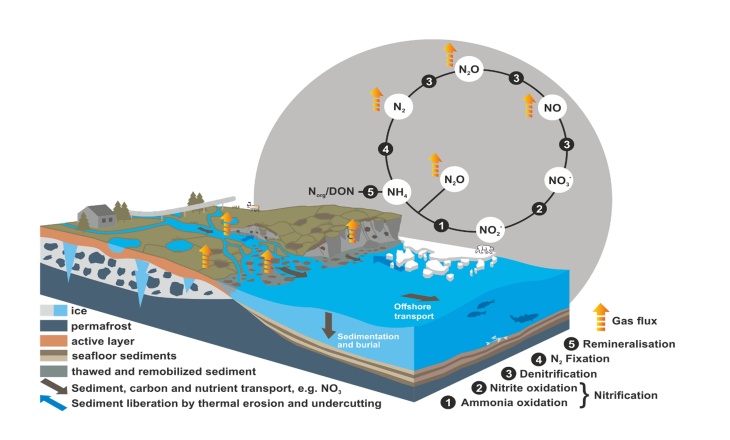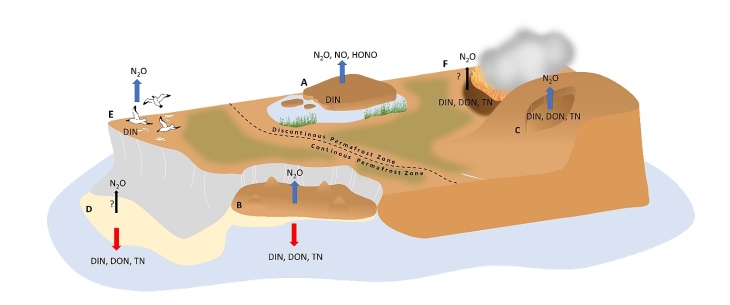Permafrost Nitrogen stock, thaw release and enhanced Nitrogen Cycling in the Arctic land-ocean continuum - Review
Context

Potential response of nearshore environments (land, river, delta, and ocean) to climate change, and potential impacts to ecosystem processes and coastal biogeochemistry. Terrestrial permafrost thaw causes landscape collapse and changing resources, affecting all visualized ecosystems. Permafrost thaw on land can affect terrestrial gas fluxes, or be mobilised into freshwaters, affecting OM reactivity and carbon and nitrogen budgets from the river, delta or gulf regions (input/output arrows). Changing terrestrial nutrient supply (black arrows) may influence nearshore nutrient budgets, and food web dynamics, altering air-sea gas fluxes (coastal inputs/outputs/processes) or essential coastal food resources. Adapted from Mann et al. 2022 by J. Strauss.
The Arctic is warming four times faster than the rest of the planet. Thawing permafrost releases huge amounts of organic carbon to water bodies and increases emissions of the greenhouse gases carbon dioxide (CO2) and methane (CH4). The permafrost affected soils also stores a similarly large proportion of nitrogen and other nutrients, which are also be released by thawing permafrost. Nitrogen regulates multiple aspects of the permafrost climate feedback, including plant growth, organic matter decomposition, and the production of nitrous oxide (N2O), a potent greenhouse gas with a 300fold increased warming potential relative to CO2. Nitrogen stored in permafrost will be released as reactive nitrogen and can follow three main pathways: (1) It will be used by plants and other primary producers, fostering the vegetation; (2) it can be transported laterally in the aquatic environment and finally reach the Arctic Ocean or, (3), it can be evaporated to the atmosphere after microbial processing as either N2 or worse in form of the greenhouse gas nitrous oxide (N2O).
This review is a synthesis of recent research dedicated to the Nitrogen cycling in the Arctic region under a pressure of climate change and global warming. It stems from the following recent articles:
Strauss, J., M.E. Marushchak, L. van Delden, T. Sanders, C. Biasi, C. Voigt, L.L. Jongejans, and C.C. Treat (2024). Potential nitrogen mobilisation from the Yedoma permafrost domain. Environmental Research Letters.
Access publication (external link)
Strauss, J., C. Biasi, T. Sanders, B.W. Abbott, T.S.v. Deimling, C. Voigt, M. Winkel, M.E. Marushchak, M. Fuchs, M.A. Horn, L.L. Jongejans, S. Liebner, J. Nitzbon, L. Schirrmeister, K.W. Anthony, Y. Yang, S. Zubrzycki, S. Laboor, C. Treat, and G. Grosse. (2022): A globally-relevant stock of soil nitrogen in the Yedoma permafrost domain. Nature Communications (2022)
Access publication (external link)
Sanders, T., C. Fiencke, M. Fuchs, C. Haugk, B. Juhls, G. Mollenhauer, O. Ogneva, P. Overduin, J. Palmtag, V. Povazhniy, J. Strauss, R. Tuerena, N. Zell, and K. Dähnke (2022): Seasonal nitrogen fluxes of the Lena River Delta. Ambio 51: 423-438
Access publication (external link)
Tuerena, R.E., C. Mahaffey, S.F. Henley, C. de la Vega, L. Norman, T. Brand, T. Sanders, M. Debyser, K. Dähnke, J. Braun, and C. März (2022): Nutrient pathways and their susceptibility to past and future change in the Eurasian Arctic Ocean. Ambio 51: 355-369
Access publication (external link)
Fiencke, C., M.E. Marushchak, T. Sanders, R. Wegner, and C. Beer (2022): Microbiogeochemical Traits to Identify Nitrogen Hotspots in Permafrost Regions. Nitrogen 3: 458-503
Access publication (external link)
The Nitrogen cycle in the Arctic
Nitrogen is one of the most important elements for life on earth, it is essential for synthesis of nucleic acids and proteins, and all cells from single cell microorganisms to human beings needs nitrogen in a reactive - usable – form. There is an apparently infinite source of nitrogen as N2 in the atmosphere, but this is inert and not bioavailable to most organisms. Hence, fixed inorganic nitrogen (also called reactive nitrogen) often limits primary production in marine and terrestrial ecosystems – especially in remote ecosystems such as the Arctic and permafrost affected regions.
Permafrost-affected soils were often considered as nitrogen-limited ecosystems, because little reactive nitrogen is available, low N2-fixation rates are reported, and low inputs by atmospheric deposition occur. Intensified by global warming and more permafrost thawing there is a need to calculate how much nitrogen can potentially be released, to have a better assessment of N-Stocks in Permafrost, to identify hot spots of nitrogen turnover und to understand the transport from land to ocean which can change the food webs in the Arctic Ocean.
Schematic permafrost landscape of a tundra ecosystem

Hotspots of high N availability in a schematic permafrost landscape of a tundra ecosystem with (A) permafrost peat plateaus and palsas with bare peat surfaces in the discontinuous permafrost zone; hillslope thermokarst landscapes such as (B) retrogressive thaw slump in the continuous and (C) thermo-erosion gully in the discontinuous permafrost zone, (D) alluvial soils in the transition between terrestrial and aquatic ecosystems, and the occurrence of (E) animal-influenced soils and (F) wildfire throughout ecosystem. Blue arrows indicate known gaseous (N2O, NO, HONOH) and red arrows indicate lateral N (DIN, DON and TN) fluxes, black arrows indicate probability of N2O loss. N form without arrow describes enrichment in soil. DIN = dissolved inorganic, DON = dissolved organic nitrogen, TN = total nitrogen, ? = the N2O emission is largely unresolved (Figure from Fiencke et al, 2022).
Nitrous oxide (N2O) production pathways
The greenhouse gas N2O can be produced by two microbial processes, nitrification and denitrification. Nitrification is the two step oxidation of ammonia/ammonium via nitrite to nitrate. During the first step of ammonia oxidation, N2O can be released if oxygen supply is insufficient. Denitrification is the anaerobic reduction of nitrate/nitrite via nitric oxide (NO) and nitrous oxide (N2O) to inert N2. N2O is an intermediate in this process and can be released to the atmosphere, if oxygen hampers the reduction of N2O to N2 or if the microbial enzyme for the N2O reduction is not expressed sufficiently.
The potential release of N2O therefore is coupled to the availability of reactive nitrogen such as ammonium and nitrate. A higher release of the nitrogen stocks from thawing permafrost can therefore intensify N2O production and release to the atmosphere.
Key Points from synthesised research
- Stocks of nitrogen in Yedoma are higher than previous estimations in permafrost-affected soils Yedoma domain in the Arctic contains more than 40 gigatons of nitrogen in the first upper 20 meters. The new estimation increases the pool by more than 45%
- Potential release of frozen nitrogen provides more reactive nitrogen In the upper 3 meters, the nitrogen pool is potentially releasable and until 2100 up to 15 Gt could be released under the RCP8.5 scenario
- Hotspots of nitrogen release Hotspots of nitrogen released in different types of permafrost-affected soils exist
- Potential increase of N2O emissions due to higher nitrogen turnover Reactive nitrogen is a source of nitrous oxide in the floodplain within the Lena Delta
- Released nitrogen from permafrost-affected soils Released nitrogen from permafrost-affected soils is available as reactive nitrogen in the Lena River and it is mainly transported as DON and nitrate
- The Lena Delta transports reactive nitrogen to the Laptev Sea. For 2018/2019 a TN fluxes of more than 240 Gt N per year was calculated
- Primary productivity in Arctic shelf seas Over the last 30 years primary productivity in Arctic shelf seas has increased
- Changing nutrients regimes Changing nutrients regimes, where either the standing nutrient stock has been depleted or the nutrients inputs have increased
- Food web in the Arctic Ocean The increase can change the food web in the Arctic Ocean
and collaborating researchers
Helmholtz Centre for Polar and Marine Research, Alfred Wegner Institute, Germany
University of Hamburg, Germany
Scottish Association for Marine Science, United Kingdom
